Anatomy of a Gimmick: The Human Centipede, “the Most Horrific Film Ever Made”
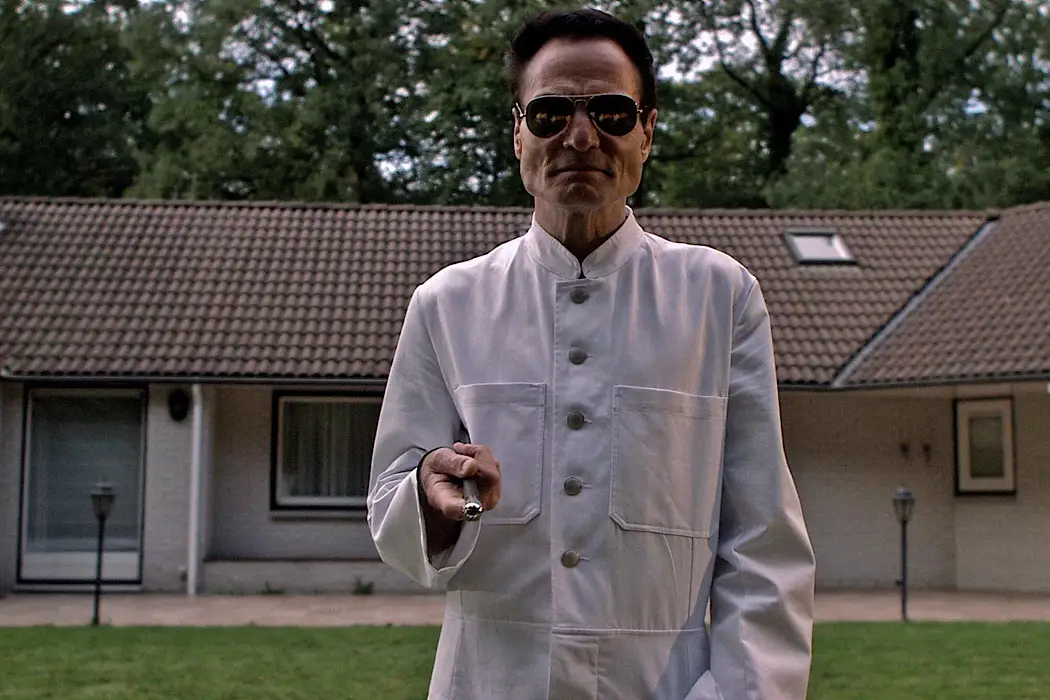
Payton McCarty-Simas is a freelance writer and artist based in…
The Human Centipede trilogy is arguably one of the most infamous horror films of recent decades, spawning a cult fandom of midnight moviegoers and a ubiquitous wave of revulsion from everyone else. The premise is most likely common knowledge to horror fans, anyone who went to middle school in the 2000s, or viewers of South Park among others–– it’s become something of an urban legend. It’s simple: a human centipede is three or more people sewn together mouth to anus in a line with the goal of creating one long, fully functional gastrointestinal tract. Who does the connecting, how many people are connected, and the reasoning behind why anyone would want to do this in the first place varies by film, but none of that matters, really–– the premise itself is what people pay to see, encouraged in large part by a prodigious word of mouth campaign begun by the film’s director.
Horrific, Infamous, or Both?
The negative, outraged reaction to the first film was instantaneous. Legendary film critic Roger Ebert called his review “a public service announcement” for “a film deliberately intended to inspire incredulity, nausea and hopefully outrage. It’s being booked as a midnight movie,” he continues, “and is it ever. Boozy fanboys will treat it like a thrill ride.”
Even with the awareness that the film is a deliberate provocation made by a filmmaker who decries “political correctness” in just about every interview, Ebert couldn’t resist feeding into the hype, calling it “depraved and disgusting” and refusing to give the film a star rating at all, a move he typically reserved for pornography (i.e. Deep Throat) and rape-revenge films (I Spit on Your Grave).
That being said, while many people over the past 13 years since the first film’s release have called The Human Centipede trilogy something along the lines of “the most horrific film ever made,” it was actually the film’s marketing campaign that said it first. The month the film was released, David Cox, writing for The Guardian, worked to track down the quote. When asked, director Tom Six claimed it was from The Sun, which proved to be false.
Alongside this sensationalist marketing tactic, another claim, this one more dramatic and completely absurd, is emblazoned on every poster: the film’s tagline insists to the reader that The Human Centipede is “100% medically accurate.”
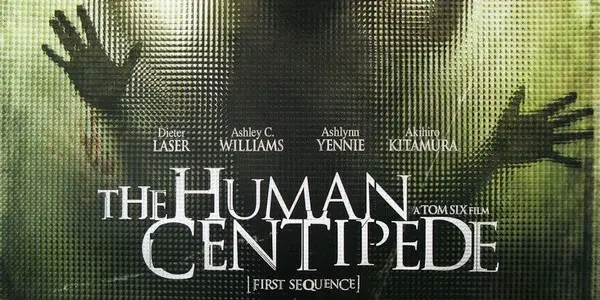
Like other horror filmmakers before him, Six’s approach to the franchise reads as one long, money-making marketing gimmick that incidentally created a film trilogy–– and that’s the point. Deadpan style aside, the movies themselves are self-referential curiosities designed to maintain a perpetual hype machine of the sort that kept stars like Vincent Price in expensive Dracula capes for decades.
This strategy allowed Six to create something infamous off the back of a first film that–– and maybe as a horror fan I’m biased–– simply doesn’t merit the hype he himself gave it. Ultimately, though, the very fact that such an infamous franchise was built off of an elaborate, self-perpetuating gimmick and not the films’ gross-out premise, makes the Human Centipede trilogy worthy of the “splatter” moniker coined for films that were doing the exact same thing more than half a century ago.
Horrific
Let’s get down to brass tax here: is The Human Centipede really that disgusting? When it comes to the first film in the trilogy, it’s a matter of taste and tolerance. All three films do indeed feature coprophagia, bodily fluids, and what the MPAA would call “graphic nudity” among other more or less depraved things. They’re stories about perverted men doing perverted things to other people, many of whom are also perverts. The first film though, is also interestingly antiseptic in the era of “torture porn” films like Saw (2004) and Hostel (2005) set in ubiquitously dingy basements full of flickering lights and rusty knives, needles, sheers, and all number of other tools of torment.
Filmed in Holland, The Human Centipede: First Sequence is set in the sterile, modern home of a crazed surgeon, Doctor Josef Heiter (Dieter Laser), whose Nazi-inspired human experiments take place in a clean, well-organized surgical theater with little on-screen blood or guts.
The centipede itself is also unexpectedly well-kempt. It consists of two American women and one Japanese man (in what Six claims is a World War II allegory, though as a metaphor it’s decidedly mixed–– why does the Josef Mengele stand-in German doctor incorporate a Japanese man into the centipede if Japan and Germany were allies? Where are the French, British, or Italians? But I digress). While the midnight moviegoer/gore-head might expect to see some anus-to-mouth contact in a film about exactly that, each victim’s face is wrapped in clean, white gauze so thoroughly that only their petrified eyes remain visible.
They crawl around moaning and protesting their own existence without doing much else for the last 40 minutes of a 90-minute movie, only giving in to what I’ll describe as nature’s call once in a set piece that relies on the implication of what’s going on under those layers of unstained linen for its shock value. Though this may sound ironic, while the strategy of eliding direct, dramatic moments for psychological impact is well-used in classier horror films from Val Lewton‘s 1940s classic, Cat People, to Spielberg‘s Jaws, for a film selling itself with human feces, this tactic seems, well, cheap.
Infamous
While the first film isn’t particularly gory for all its grotesquerie, the marketing campaign and the infamy it spawned has an incredible amount of historical precedence in the genre. In 1963, Herschell Gordon Lewis‘ first horror film, Blood Feast, was banned from traditional cinemas for its cannibalistic subject matter and gore made of real animal entrails. It ran at drive-in movie theaters to great financial success. This film, and the countless dozens he made subsequently, earned him the name the “Godfather of Gore” and created what became known as the “gore”–– or “splatter” subgenre as George Romero called it–– of horror films.
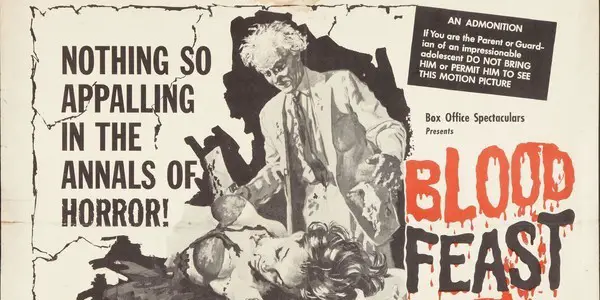
That said, the film’s success was due less to its premise and more to the word of mouth generated by the marketing tactics Lewis used. In the 1950s, Lewis began his career in advertising, later graduating to that classic money-making genre, softcore pornography (or, “nudie-cuties” with titles like Boin-n-g! and Goldilocks and the Three Bares).
With Blood Feast, Lewis and his crew engaged in a series of stunts similar to Six‘s fabricated quote from The Sun, providing viewers with vomit-bags upon entry and filing lawsuits for indecency against their own film. The tagline on the film’s poster read: “Nothing so appalling in the annals of horror!” Sound familiar?
Earlier horror films by infamous exploitation director and producer William Castle, known as “the master of gimmicks” or “the abominable showman,” included similar tactics, for example hiring a woman to faint mid-screening of his 1959 film The Tingler, or insuring the audience members in case of death from fright for his film Macabre in 1958.
In the 1990s, these types of campaigns came back to the fore with films like The Blair Witch Project (1999). This found footage horror classic employed assurances of veracity to market itself to large audiences on a small budget. Missing person posters of the characters in the film were put up as part of a stunt to convince viewers the film depicted the real demise of its cast. During early screenings, the promotional team would pass out flyers encouraging audiences to come forward to the police with any information they may have about the case, and, most famously, their website included “real” clips of police and investigators discussing the case, making it one of the most viewed websites of its time.
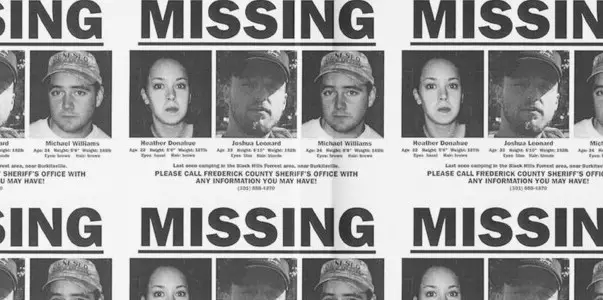
In the late 2000s and early 2010s, other horror films like Paranormal Activity piggybacked off of this type of marketing with self-referential trailers simply showing audiences screaming in the theater. The poster for Evil Dead (2013) shouts “the most terrifying film you will ever see.” The Devil Inside (2012) (“inspired by true events”) includes a quote on its poster insisting that this is “the film the Vatican doesn’t want you to see” and went even further by ending the film with an abrupt cut to black instead of a climax, followed by a title card instructing audiences to go to a website “for more information on the ongoing investigation.”
The Human Centipede trilogy, then, was conceived in a fertile moment for horror film gimmickry and exists in a long line of low-budget horror films, many of which claim to be the most horrific films of all time. The sequels work harder still to perpetuate the gimmicks and strategies laid out by the first film’s marketing as they carry out their twisted premise.
“100% Medically Accurate”
The Human Centipede 2 (Full Sequence) (2011) is, indeed, that gross, but it’s also designed to continue building up the legend of the first film. Tom Six asserts that each film within the trilogy is one segment in a film centipede because each film leaves off right where the next begins. This move allows Six to begin each movie with a breaking of the fourth wall, showing the last film’s final moments and credits, reorienting the viewer not towards the story of The Human Centipede, but to the films themselves, each of which is a fiction film in the diegesis of its successors.
The second film in particular seems designed to poke fun at the fans whose morbid curiosity allowed Six to get it made after the revulsion the original inspired.
The second film follows a nonverbal, Human-Centipede-obsessed fan, Martin (Laurence R. Harvey), through his tragic and repellant life defined by conflicts with his abusive mother (and everyone else). Driven by his goal to see if Six‘s claim that the first film in the trilogy is indeed “100% medically accurate,” he clumsily kidnaps people at gunpoint and attempts the centipede surgery with duct tape, his mother’s kitchenware, and zero medical expertise. Rape, infanticide, murder, and human-centipeding abound, likely meeting the expectations of the most avowed gore-heads. His mother and psychologist both abhor his love of the first film–– serving as a mouthpiece for negative critical reception.
In terms of motivation, Freudian nods and winks from phallic cigars to Oedipus complexes hardly attempt to elide the fact that the character’s central motive for building a Human Centipede is just the perverted draw of the last movie. He keeps a scrapbook with clippings from the first film under his bed (100% medically accurate” emblazoned across the first page) and kidnaps the actors from the first film (playing themselves and talking up how scary and, again, 100% medically accurate the film is) to add to his own centipede.
Even his other victims have all seen or heard of The Human Centipede (2009): one man goes so far as to explain to his fellow captives that they’re about to be sewn together “like that movie The Human Centipede!”
The trailer for the second film even includes a clip of Martin’s mother holding his scrapbook and exclaiming: “What is this??? One hundred percent medically accurate??? Is this a perverted film you’ve been talking about???” neatly closing the self-promotion loop (the self-promotion centipede?) of film and film marketing.
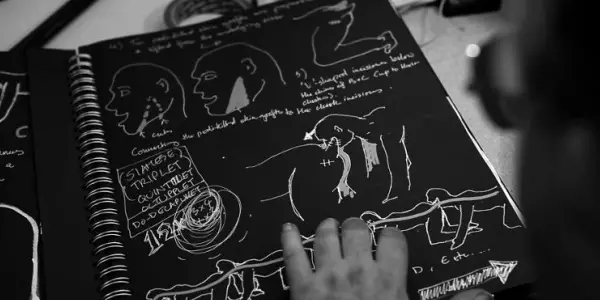
The third film, inexplicably a comment on the US prison system, does much the same. The actors who played the villains in the first two films are back as other characters (the resemblances don’t go unmentioned), and decide the best way to handle prison overpopulation is, of course, a human centipede. Lawrence R. Harvey waves DVD copies of the first two films around, leaves them on Dieter Laser‘s character’s desk, and invites Tom Six himself to visit George H.W. Bush Prison (like the first film, getting into the themes of The Human Centipede 3 (Final Sequence) would require more time than I’m willing to dedicate to such muddled metaphors) to watch the surgeries take place. Everyone from the prison doctor to the office secretary is “a big fan” of Six‘s work.
Changing Times
The Human Centipede trilogy may not be “the most horrific film ever made,” but it can’t be dismissed as simple exploitation horror meant to shock people’s wallets open either. These films, due to an incredibly effective hype campaign in tandem with their taboo-breaking premise, left a deep mark on the horror film landscape and American culture writ large. The same can be said for Blood Feast, The Blair Witch Project, and even Paranormal Activity before them. From truly masterful classics to popcorn films, culturally shocking, low-budget horror movies whose marketing campaigns succeed on this scale become embedded in our culture.
The Human Centipede trilogy effectively built Tom Six‘s reputation as a master of the grotesque, too. However, that moniker has lost some of its pull with the changing film industry in a moment when gimmickry is no longer horror’s bread and butter and “elevated horror” a la A24 and IPs like Halloween dominate culturally.
The hype machine Tom Six built still exists, as evidenced by memes, t-shirts, and Six’s own Tweets with compilations of references to the Human Centipede ranging from SNL sketches to interviews with Megan Thee Stallion (what he calls, “true pop culture, baby!”). That being said, none of this has helped him get his latest film, The Onania Club released. Audience tastes, at least for now, seem to have moved on.
Nevertheless, the influence of The Human Centipede shouldn’t be understated. To quote Megan Thee Stallion: “we needed it for the culture.”
What do you think? Is The Human Centipede really the most horrific film ever made? Let us know in the comments!
Does content like this matter to you?
Become a Member and support film journalism. Unlock access to all of Film Inquiry`s great articles. Join a community of like-minded readers who are passionate about cinema - get access to our private members Network, give back to independent filmmakers, and more.
Payton McCarty-Simas is a freelance writer and artist based in New York City. They grew up in Massachusetts devouring Stephen King novels, Edgar Allan Poe stories, and Scooby Doo on VHS. Payton holds a masters degree in film and media studies from Columbia University and her work focuses on horror film, psychedelia, and the occult in particular. Their first book, One Step Short of Crazy: National Treasure and the Landscape of American Conspiracy Culture, is due for release in November.












